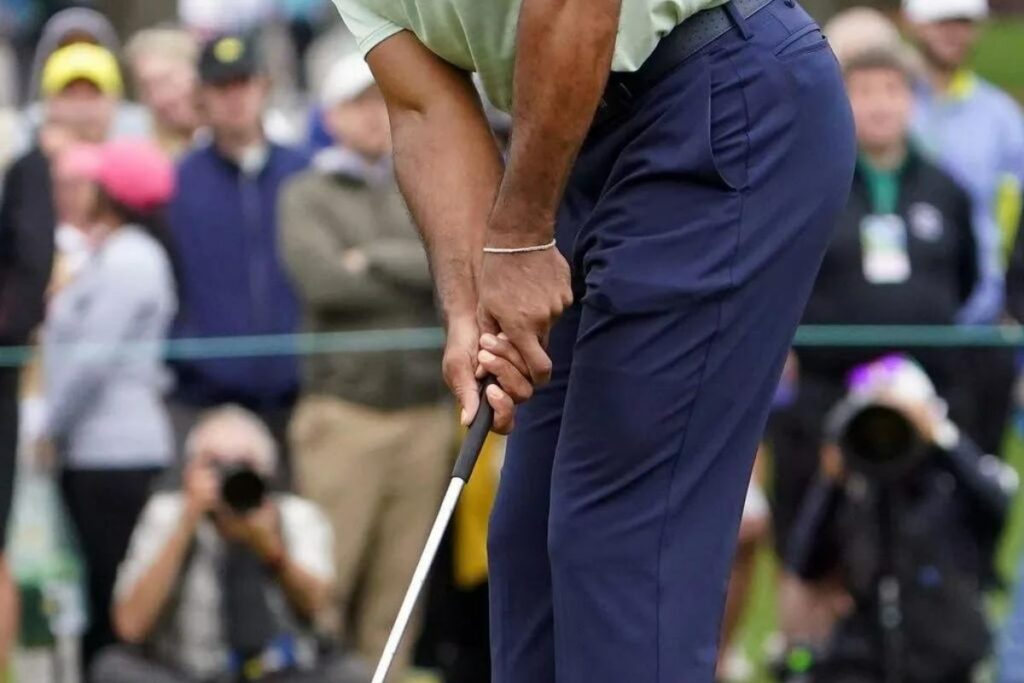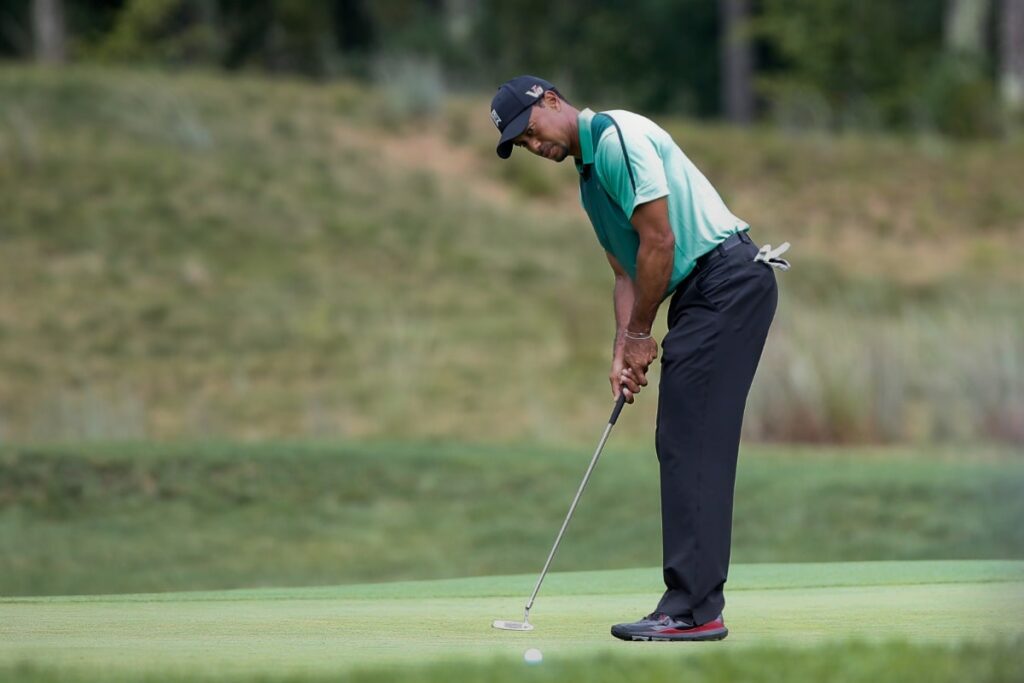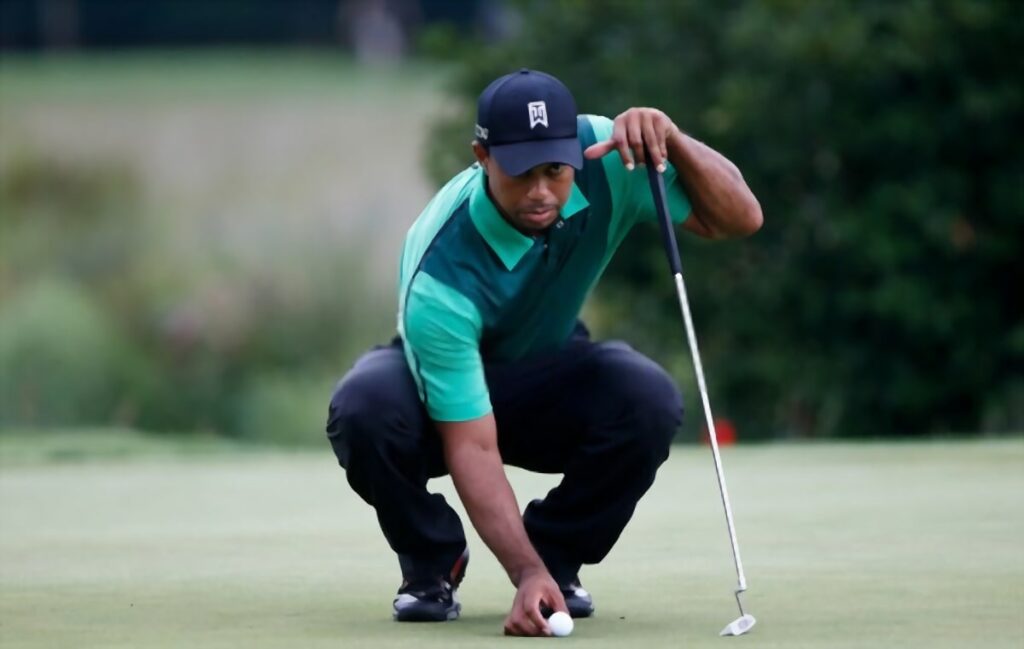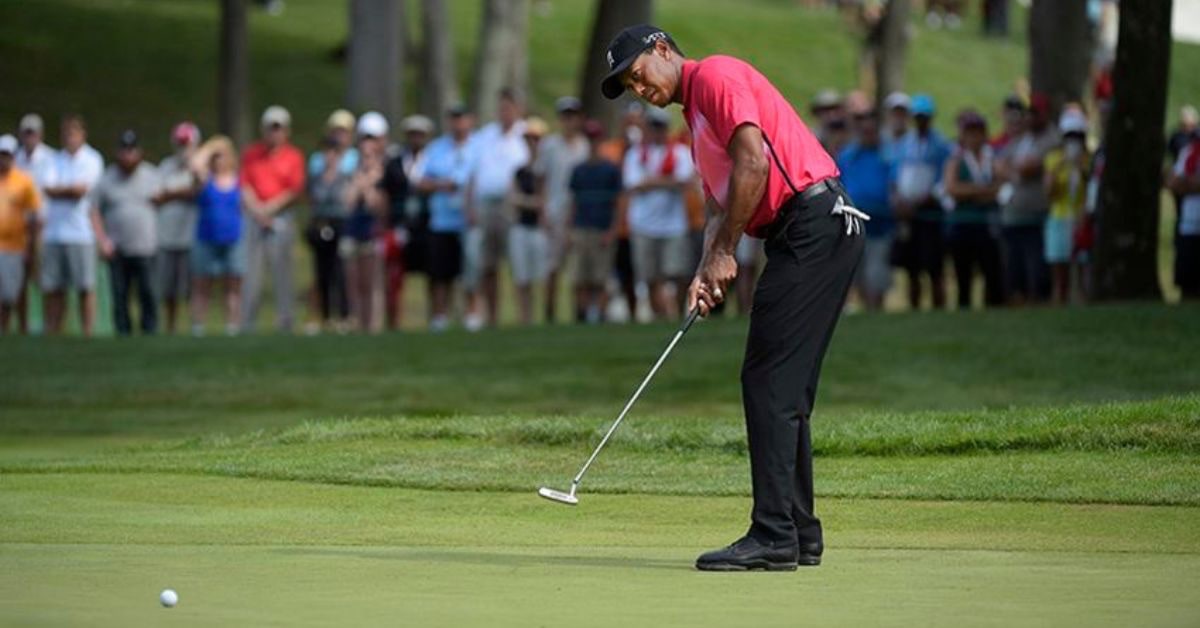Since becoming the youngest to win the Masters in 1997, Tiger Woods has undoubtedly become one of the greatest golfers to ever grace the sport.
However, nothing amazes fans more than his ability to putt under pressure. Between the years 2002-05, he missed just three putts out of 1,543 inside 3 feet.
In this article, you’ll learn everything about Tiger Woods’ putting grip.
Along with a full analysis of his grip technique, you’ll discover the most valuable putting tips that he’s shared throughout his immensely successful golf career.
Ready? Let’s go!
Tiger Woods Putting Grip
Tiger Woods uses a reverse overlap putting grip. This involves overlapping the top hand’s index finger over two fingers on the bottom hand. The reverse overlap grip is the most common putting grip technique and reverses the traditional overlap grip used by many golfers for a full golf swing.

Reverse Overlap Putting Grip
The reverse overlap putting grip is a very common way of gripping the putter, for amateurs and pros alike. The putter grip runs down the palms of the hands, with the top hand’s index finger overlapping the pinky and ring fingers of the lower hand.
The technique is referred to as the reverse overlap grip because it reverses the typical overlap grip used by many golfers for a full swing with the clubs in the bag.
It’s the most common putting grip in golf — used far more frequently than alternatives such as the interlocking putter grip or the claw grip.
Tiger Woods has used the reverse overlap grip for the entirety of his professional career, helping him to a whopping total of 110 wins including 15 majors.
In addition to Woods himself, Rory McIlroy, Jason Day, and Dustin Johnson are all notable users of the reverse overlap putting grip. In fact, around 68 percent of players on the PGA Tour use this conventional grip.
How It Works
The reverse overlap grip is a slight variation of the grip you use for a full swing.
First, hold the putter grip about halfway down with your right hand. Run the grip down your palm — rather than your fingers — with your thumb on the center of the grip.
Next, place your left hand above your right hand, at the top of the grip. Position your left thumb on the center of the grip, in line with your right thumb.
Your left index finger should overlap your right hand’s pinky and ring fingers. This ensures both hands work in unison throughout the putting stroke.
The reverse overlap grip method helps prevent the hands from rolling and keeps the grip secured in each palm, increasing control through the stroke.

The Importance of Grip Pressure
Tiger Woods credits a lot of his success on the putting green to his ability to feel the connection between his hands and the putter head.
To have good feel when putting, you need to have a light grip pressure. Grip the putter too firmly, and you’ll lose the sensitivity needed for good distance control.
Tiger learned this first-hand. At the 1997 AT&T Pebble Beach Pro-Am, he’d opened with a lackluster 70-72 in the first two rounds. During a lesson before his third round, Ben Crenshaw emphasized the importance of holding the putter loosely:
“He had me loosen up my hands, get my putter head behind my hands, and from there let the weight of the putter head hit the ball. I ended up shooting 63-64 in a weekend.”
Tiger Woods on his putting lesson with Ben Crenshaw in 1997
This shows how important it is to grip the putter with light pressure. It allows you to feel the weight of the putter head through the stroke, improving your distance control.
Watch Tiger’s fascinating recollection of the putting lesson below:
Tiger Woods Putting Drill
Before every round of golf, Tiger Woods has always relied on a definitive putting warmup routine to get him prepared for the greens.
First, he begins hitting short putts one-handed, using his bottom hand only.
He will do this for several minutes from various positions around the hole, getting comfortable with the feeling of guiding putts with his dominant hand.
Once he’s found a putt that breaks the way he likes, he sets a couple of tees on either side of his putter head to create a narrow pathway for his putter.
He will then hit lots of putts through the tees — this is known as the gate drill.
It helps him become used to the sensation of striking the center of the putter face. Also, it builds his consistency over those short putts, through muscle memory.
Check out Tiger’s gate drill below, where he sinks putt after putt for minutes:
Tiger Woods Putter Grip
It’s a well-known fact that Tiger Woods is very particular about his equipment.
In his first championship win at the 1997 Masters, Tiger used a Scotty Cameron putter grip. But ever since, he’s used one single grip model: the Ping PP58 “Blackout” Grip.
This grip employs Ping’s classic pistol grip design, which is very thin and provides excellent feel and instant feedback between the ball and the hands.
Tiger prefers to rest both thumbs on the top of the grip, which works comfortably with the flat upper edge of the Ping PP58. Additionally, the thinness of the grip enables him to naturally roll his hands through his arc stroke — his signature move.
The PP58 is a blend of natural and synthetic rubber, which can quickly get slick when exposed to the sun. So, Tiger is known to switch out his grip regularly.

Conclusion
In summary, Tiger Woods uses a reverse overlap putting grip technique. The putter grip runs down the palms of the hands, with the top hand’s index finger overlapping the pinky and ring fingers of the lower hand.
While his putting style has evolved in small ways over the years, his grip style has remained continuous throughout his stellar career.
One piece of advice he credits greatly is to grip the club with light pressure, which enables him to feel the weight of the putter head through the stroke.
Ultimately, Tiger’s is certainly not a bad putting grip to model your game after!


